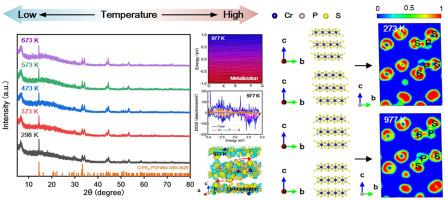Temperature induced lattice vibration and electronic structural behaviors of CrPS4
IF 2.8
3区 物理与天体物理
Q2 PHYSICS, CONDENSED MATTER
引用次数: 0
Abstract
The temperature-dependent lattice vibration and electronic structure behaviors are undoubtedly worthy of theoretical and experimental attention for two-dimensional (2D) van der Waals (vdW) semiconductor CrPS4. Enhanced thermal vibration leads to lattice distortion of tightly packed S atoms and monoclinically metrically arranged Cr and P atoms. The AI-VI-type Raman modes (298–673 K) exhibit continuous intensity weakening with a blue shift, whereas the BI-II-type Raman modes first reach minimum intensity at 373 K before transforming into the BIII mode, with an initial intensity enhancement followed by weakening accompanied by a red shift. The lattice symmetry destruction theoretically promotes the temperature-induced metallization transition at about 977 K, characterized by enhanced contributions from s-orbitals (P and S atoms) near the Fermi level (EF), with a distinct trend of electronic state delocalization under action of temperature. This work thus elucidates fundamental insights into their potential as temperature-adaptive electronic devices in the CrPS4-type family.

CrPS4的温度诱导晶格振动及电子结构行为
二维(2D)范德华(vdW)半导体CrPS4的晶格振动和电子结构行为无疑是值得理论和实验关注的。热振动的增强导致S原子紧密排列和Cr、P原子单临床计量排列的晶格畸变。ai - vi型拉曼模式(298 ~ 673 K)的强度随着蓝移而持续减弱,而bi - ii型拉曼模式在373 K时强度达到最小,然后转变为BIII模式,初始强度增强,随后减弱并伴有红移。晶格对称破坏理论上促进了977 K左右温度诱导的金属化转变,其特征是费米能级(EF)附近S轨道(P和S原子)的贡献增强,并且在温度作用下有明显的电子态离域趋势。因此,这项工作阐明了它们作为crps4型家族中温度自适应电子器件的潜力的基本见解。
本文章由计算机程序翻译,如有差异,请以英文原文为准。
求助全文
约1分钟内获得全文
求助全文
来源期刊

Physica B-condensed Matter
物理-物理:凝聚态物理
CiteScore
4.90
自引率
7.10%
发文量
703
审稿时长
44 days
期刊介绍:
Physica B: Condensed Matter comprises all condensed matter and material physics that involve theoretical, computational and experimental work.
Papers should contain further developments and a proper discussion on the physics of experimental or theoretical results in one of the following areas:
-Magnetism
-Materials physics
-Nanostructures and nanomaterials
-Optics and optical materials
-Quantum materials
-Semiconductors
-Strongly correlated systems
-Superconductivity
-Surfaces and interfaces
 求助内容:
求助内容: 应助结果提醒方式:
应助结果提醒方式:


